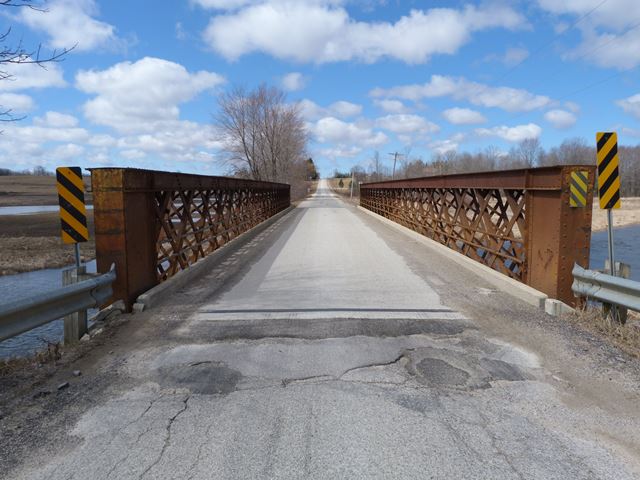We Recommend:
Bach Steel - Experts at historic truss bridge restoration.
BridgeHunter.com Phase 1 is released to the public! - Visit Now
McPherson Bridge
Concession Road 8 Bridge

Primary Photographer(s): Nathan Holth and Rick McOmber
Bridge Documented: April 15, 2015
South Bruce: Bruce County, Ontario: Canada
By Builder/Contractor: Unknown
Not Available or Not Applicable
110.0 Feet (33.5 Meters)
110.0 Feet (33.5 Meters)
Not Available
1 Main Span(s)
Not Applicable

View Information About HSR Ratings
Bridge Documentation
This bridge is nearly identical to the Dudgeon Bridge's truss span seen on, and the two truss spans may share a common history, since the Dudgeon Bridge's truss span is a relocated span, this truss on Concession Road 8 may be similarly relocated. The Dudgeon Bridge's lattice truss span was reportedly a former railway span that was reconfigured for highway use. Both spans may have come from the same original bridge, in an unknown location. Despite the similarities of these two bridges, both bridges are otherwise unique among the thousands of bridges in Canada and the United States on HistoricBridges.org. These two bridges may be the only examples of their kind in North America. Quadruple Warren truss bridges in North America generally are found as through or deck truss bridges, not pony truss bridges. The bridges, with their lattice pony truss configuration and unusual vertical end posts, are strongly reminiscent of a European style of bridge known as a lattice girder bridge. Europe's lattice girder bridges generally will have lighter and more numerous diagonal members forming a very tight lattice, but the overall visual appearance is strikingly similar. European lattice girder bridges are often pony truss bridges.
Please visit the Dudgeon Bridge page for a more detailed discussion about these two bridges and the features that make them unique and among the most significant heritage bridges in Ontario, a distinction that it is sadly unrecognized by local residents and government, particularly with this bridge. The bridge did make an appearance in an undated photo on a website with family photos from the collection of Catherine Taylor-Lamb and Lizzie Lamb-Kincaid who apparently had a farm near the bridge. The photo below was captioned as "new bridge." It was also labeled Gregg's Bridge, which may be the local name for this bridge.


Unlike the Dudgeon Bridge, the Concession Road 8 shows some empty rivet holes, located on a couple of the end posts. These empty holes show where a diagonal member used to be located but is today missing. It is not known why the diagonal member is missing, and whether it has anything to do with the relocation of the bridge.

![]()
Photo Galleries and Videos: McPherson Bridge
Bridge Photo-Documentation
Original / Full Size PhotosA collection of overview and detail photos. This gallery offers photos in the highest available resolution and file size in a touch-friendly popup viewer.
Alternatively, Browse Without Using Viewer
![]()
Bridge Photo-Documentation
Mobile Optimized PhotosA collection of overview and detail photos. This gallery features data-friendly, fast-loading photos in a touch-friendly popup viewer.
Alternatively, Browse Without Using Viewer
![]()
Maps and Links: McPherson Bridge
Coordinates (Latitude, Longitude):
Search For Additional Bridge Listings:
Additional Maps:
Google Streetview (If Available)
GeoHack (Additional Links and Coordinates)
Apple Maps (Via DuckDuckGo Search)
Apple Maps (Apple devices only)
Android: Open Location In Your Map or GPS App
Flickr Gallery (Find Nearby Photos)
Wikimedia Commons (Find Nearby Photos)
Directions Via Sygic For Android
Directions Via Sygic For iOS and Android Dolphin Browser

